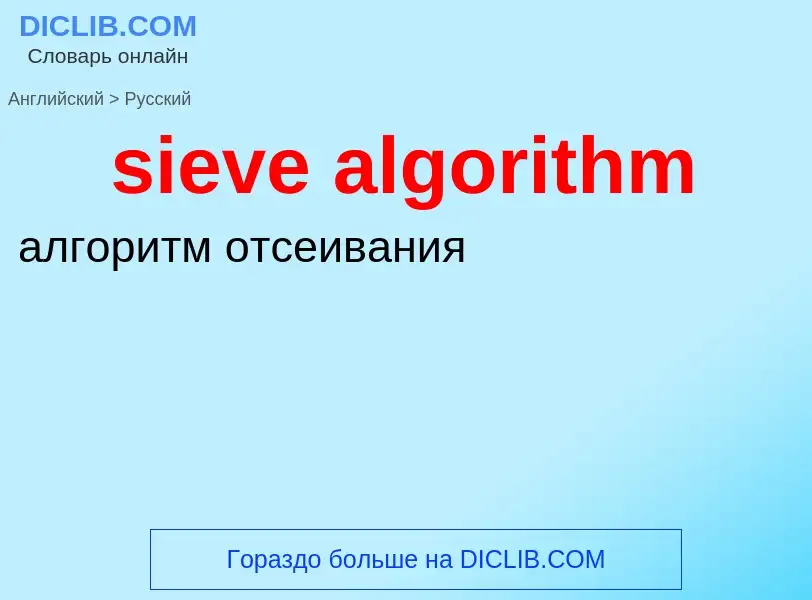Перевод и анализ слов искусственным интеллектом ChatGPT
На этой странице Вы можете получить подробный анализ слова или словосочетания, произведенный с помощью лучшей на сегодняшний день технологии искусственного интеллекта:
- как употребляется слово
- частота употребления
- используется оно чаще в устной или письменной речи
- варианты перевода слова
- примеры употребления (несколько фраз с переводом)
- этимология
sieve algorithm - перевод на русский
математика
алгоритмический метод
['ælgərið(ə)m]
общая лексика
алгоритм
математическая функция или конечный набор описаний конкретной последовательности действий (правил), необходимых для того, чтобы компьютер или интеллектуальное устройство выполнили за конечное время некоторую задачу, сжатие изображения, выбор оптимального маршрута пересылки пакета или шифрование данных. Алгоритм может быть описан блок-схемой. Термин происходит от имени древнеперсидского математика Мухаммеда ибн Муса аль Харезми, написавшего трактат, посвященный алгоритмическому методу
метод, правило
синоним
существительное
специальный термин
алгоритм
- access algorithm
- anti-virus algorithm
- approximate algorithm
- assymetric algorithm
- audio scrambling algorithm
- authentication algorithm
- B-Crypt algorithm
- block cipher algorithm
- block-encryption algorithm
- bit sequence generating algorithm
- breaking algorithm
- cipher algorithm
- ciphering algorithm
- classified algorithm
- code-breaking algorithm
- coding algorithm
- collision resolution algorithm
- combinaforial algorithm
- compression algorithm
- confidentiality algorithm
- correlation algorithm
- crypt algorithm
- cryption algorithm
- cryptoanalytic algorithm
- cryptographic algorithm
- data authentication algorithm
- data encryption algorithm
- data reduction algorithm
- DEA algorithm
- decoding algorithm
- DES algorithm
- deterministic algorithm
- dichotomic algorithm
- digital encryption algorithm
- digital signature algorithm
- double-key algorithm
- double transposition algorithm
- dual key algorithm
- e-d algorithm
- encryption algorithm
- encryption-decryption algorithm
- error correction algorithm
- Euclidean algorithm
- Euclid's algorithm
- exponential time algorithm
- exponentiation algorithm
- factoring algorithm
- factorization algorithm
- fast data encryption algorithm
- FEAL algorithm
- fixed algorithm
- Fourier transform algorithm
- handshaking algorithm
- hashing algorithm
- heuristic algorithm
- international encryption algorithm
- key-controlled algorithm
- key-dependent algorithm
- key distribution algorithm
- key generation algorithm
- key input algorithm
- keyed algorithm
- key exchange algorithm
- key expansion algorithm
- key management algorithm
- key shedule algorithm
- key stream algorithm
- knapsack algorithm
- linear predictive coding algorithm
- linear sieve algorithm
- meet-in-the-middle algorithm
- message authentification algorithm
- message digest algorithm
- modification defection encryption algorithm
- modular algorithm
- modular multiplication algorithm
- non-linear algorithm
- one-way encryption algorithm
- password algorithm
- password cracking algorithm
- password encryption algorithm
- password generation algorithm
- permutation algorithm
- polynomial algorithm
- polynomial time algorithm
- predicting algorithm
- prediction algorithm
- primality testing algorithm
- private cryptographic algorithm
- probabilistic algorithm
- proprietary encryption algorithm
- protection algorithm
- protection mechanism algorithm
- p-time algorithm
- public key algorithm
- quadratic sieve factoring algorithm
- Rivest-Shamir-Adleman algorithm
- public transformation algorithm
- quaternary DES algorithm
- randomizing algorithm
- recognition algorithm
- recursive algorithm
- routing algorithm
- RSA algorithm
- RSA B safe algorithm
- scrambling algorithm
- search algorithm
- secret key algorithm
- secret transformation algorithm
- SEEK algorithm
- secure exchange of keys algorithm
- shortest path algorithm
- sieve algorithm
- signal processing algorithm
- signal reconstruction algorithm
- signature algorithm
- single-key algorithm
- solving algorithm
- standard encryption algorithm
- standardized encryption algorithm
- stream cipher algorithm
- strong algorithm
- substitution algorithm
- substitution-permutation encryption algorithm
- transformational algorithm
- unbreakable algorithm
- user-modified algorithm
- verification algorithm
- Vitterbi algorithm
- vocoding algorithm
- voice-digitising algorithm
- voice encoding algorithm
математика
алгоритм кодирования
кодирующий алгоритм
- almost-dual algorithm
- approximation algorithm
- best-route algorithm
- composite simplex algorithm
- control algorithm
- decomposition algorithm
- dual algorithm
- dual simplex algorithm
- estimation algorithm
- maximin algorithm
- minimax algorithm
- network algorithm
- operative algorithm
- optimal path algorithm
- optimization algorithm
- prediction algorithm
- primal algorithm
- primal-dual algorithm
- search algorithm
- shortest route algorithm
- transportation algorithm
- verification algorithm
Википедия
Sieve elements are specialized cells that are important for the function of phloem, which is a highly organized tissue that transports organic compounds made during photosynthesis. Sieve elements are the major conducting cells in phloem. Conducting cells aid in transport of molecules especially for long-distance signaling. In plant anatomy, there are two main types of sieve elements. Companion cells and sieve cells originate from meristems, which are tissues that actively divide throughout a plant's lifetime. They are similar to the development of xylem, a water conducting tissue in plants whose main function is also transportation in the plant vascular system. Sieve elements' major function includes transporting sugars over long distance through plants by acting as a channel. Sieve elements elongate cells containing sieve areas on their walls. Pores on sieve areas allow for cytoplasmic connections to neighboring cells, which allows for the movement of photosynthetic material and other organic molecules necessary for tissue function. Structurally, they are elongated and parallel to the organ or tissue that they are located in. Sieve elements typically lack a nucleus and contain none to a very small number of ribosomes. The two types of sieve elements, sieve tube members and sieve cells, have different structures. Sieve tube members are shorter and wider with greater area for nutrient transport while sieve cells tend to be longer and narrower with smaller area for nutrient transport. Although the function of both of these kinds of sieve elements is the same, sieve cells are found in gymnosperms, non-flowering vascular plants, while sieve tube members are found in angiosperms, flowering vascular plants.



![Alan Turing's statue at [[Bletchley Park]] Alan Turing's statue at [[Bletchley Park]]](https://commons.wikimedia.org/wiki/Special:FilePath/Alan Turing.jpg?width=200)






![compass]] in a painting of about 1474. compass]] in a painting of about 1474.](https://commons.wikimedia.org/wiki/Special:FilePath/Euklid.jpg?width=200)

